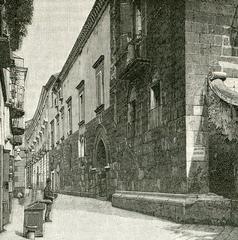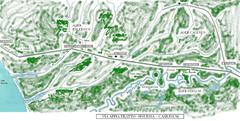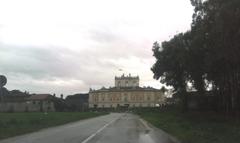
Visiting Via Ettore Fieramosca in Capua, Italy: Everything You Need to Know
Date: 01/08/2024
Introduction
Via Ettore Fieramosca, nestled in the historic town of Capua, Italy, offers visitors a unique opportunity to delve deep into the rich tapestry of history and culture that defines this ancient locale. Named after the famed Italian condottiero Ettore Fieramosca, celebrated for his valor in the Battle of Barletta in 1503, this street is a living testament to Capua’s storied past. Capua itself, strategically located on the river Volturno, has been a significant center from the Roman era to the present, boasting over 2,000 years of continuous history (Italy This Way). The Via Appia, an ancient Roman road of great importance, runs through Capua, highlighting the town’s pivotal role in trade and military movements during the Roman period. Today, visitors can explore a myriad of historical sites, from the impressive Capua Cathedral to the intriguing Museo Campano, all located along or near Via Ettore Fieramosca. This guide aims to provide a comprehensive overview of these attractions, including visiting hours, ticket information, and travel tips, ensuring a well-rounded and enriching experience for anyone planning to visit this historic street.
Table of Contents
- Introduction
- Ancient Origins and Roman Influence
- Medieval and Renaissance Periods
- Religious and Cultural Heritage
- The Norman Influence
- Artistic and Archaeological Treasures
- Modern Contributions
- Agricultural and Culinary Heritage
- Preservation and Restoration
- Visitor Information
- FAQ
- Conclusion
Exploring Capua: Historical Sites, Visiting Hours, and Tickets
Ancient Origins and Roman Influence
Capua was a significant center during the Roman era, renowned for its strategic location and cultural importance. The Via Appia, one of the earliest and most crucial Roman roads, runs through Capua, connecting Rome to Brindisi and facilitating trade and military movements. Today, the main street in Capua, Corso Appio, is named after this ancient consular road, highlighting its historical significance (Italy This Way).
Medieval and Renaissance Periods
During the Middle Ages, Capua continued to be an important regional hub. The town hall, located in the Piazza of Judges, dates back to the 16th century and features a façade adorned with seven busts taken from the Amphitheatre of Santa Maria Capua Vetere. This amphitheater is one of the largest in Italy and was a significant venue for gladiatorial games during the Roman period (Italy This Way).
Religious and Cultural Heritage
Capua is home to numerous churches with unique historical and architectural features. The Capua Cathedral, originally built in the 9th century, has undergone several renovations. The cathedral’s bell tower, with its three levels of double lancet windows and ancient columns, is a striking feature. Inside, visitors can find the candelabra of the Easter candle dating back to the 13th century and a painting of the Assumption by Francesco Solimena in the apse (Italy This Way).
Other notable churches include Saint Giovanni a Corte, Saint Michele a Corte, and St. Salvatore Maggiore a Corte. These churches feature architectural elements such as mullioned windows, arches, and frescoes (Italy This Way).
The Norman Influence
The Castello delle Pietre, or “Castle of the Stones,” was the residence of the Normans when they controlled the area in the 11th century. This castle, dominated by a massive keep, was further expanded in the 19th century. The construction materials for the tower were sourced from the Amphitheatre of Capua, linking the medieval structure to the town’s ancient past (Italy This Way).
Artistic and Archaeological Treasures
The Museum of the Palazzo Antignano is a major attraction in Capua, housing numerous artifacts from the ancient ruins at Santa Maria Capua Vetere. This museum, an example of Catalan art, exhibits about two hundred votive statues of the “Mothers” from the sanctuary dedicated to the Italic Goddess Mater Matuta (Italy This Way).
Modern Contributions
In more recent history, Capua has continued to contribute to Italy’s cultural landscape. The Helmet of Fieramosca, a monumental bronze and steel sculpture by Arturo Casanova, stands in Piazza Umberto I. This work, composed of about 150 bronze plates welded together, measures 9 meters in height and 6 meters in diameter, weighing approximately 15 tons. Before its installation in Capua, the helmet was exhibited at the Venice Biennale in 2011 (Wikipedia).
Agricultural and Culinary Heritage
Capua is renowned for its production of buffalo mozzarella, a tradition dating back to Roman times and the early Middle Ages. The fertile area around Capua, with its temperate conditions and abundance of standing water, is ideal for buffalo farming (Italy This Way).
Preservation and Restoration
Efforts to preserve and restore Capua’s historical landmarks have been ongoing. The Ponte Romano, or Roman Bridge, to the north of Capua, was rebuilt after World War II with great attention to maintaining its historical characteristics (Italy This Way).
Visitor Information
- Visiting Hours: Most historical sites in Capua are open from 9 AM to 5 PM. Check specific site details for exact hours.
- Tickets: Prices vary by site, with many museums and churches offering discounted rates for students and seniors. It is advisable to purchase tickets in advance, especially during peak tourist seasons.
- Travel Tips: Wear comfortable walking shoes and bring a water bottle. Guided tours are available and highly recommended for a richer experience.
- Nearby Attractions: Don’t miss the nearby town of Santa Maria Capua Vetere and its ancient ruins.
- Accessibility: Many sites are accessible to visitors with mobility issues, but it’s best to check in advance.
FAQ
-
What are the main historical sites to visit in Capua?
- Capua Cathedral, Castello delle Pietre, and the Museum of the Palazzo Antignano.
-
Are there guided tours available?
- Yes, guided tours are available and recommended for a comprehensive experience.
-
What is the best time to visit Capua?
- Spring and early autumn are ideal for pleasant weather and fewer crowds.
Conclusion
Capua offers a rich tapestry of history, from its ancient Roman origins to its medieval significance and modern contributions. The town’s numerous churches, monuments, and museums provide a fascinating glimpse into its storied past. Whether exploring the ancient ruins, admiring the architectural marvels, or savoring the local mozzarella, visitors to Capua are sure to have a memorable experience steeped in history and culture. For more travel tips and updates, consider downloading the mobile app Audiala, and check out other related posts or follow us on social media.
References
- Italy This Way. (n.d.). Capua. https://www.italythisway.com/places/capua.php
- Wikipedia. (n.d.). Helmet of Fieramosca. https://en.wikipedia.org/wiki/Helmet_of_Fieramosca
- Capua Cathedral. (n.d.). Official website. https://www.cattedraledicapua.it
- Museo Campano. (n.d.). Official website. http://www.museocampano.it
- Teatro Ricciardi. (n.d.). Official website. http://www.teatroricciardi.it
- TripAdvisor. (n.d.). Restaurants in Capua. https://www.tripadvisor.com/Restaurants-g187778-Capua_Province_of_Caserta_Campania.html
- Capua Online. (n.d.). Tourism website. http://www.capuaonline.com


